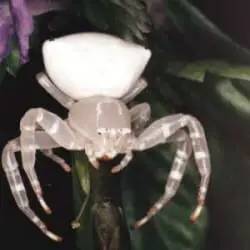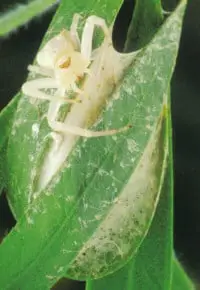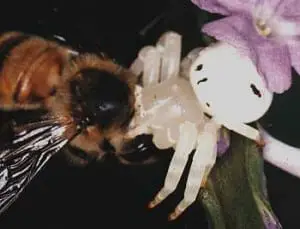The scientific name for the Australian crab spider is Thomisus spectabilis. It is named Crab Spider because it has white or yellow stout legs which are held like a crab. The full size of the Flower Spider is between four and ten millimeters. Australian Crab Spiders are often white or yellow, some have green, brown or rosy tints on the abdomen. The females are small and their legs are less than 7 mm long. The males are even smaller, but their legs are longer. They normally have two large front eyes and have very well-developed eyesight.
Table of Contents
Habitat:
Each Australian Crab Spider takes a flower as its hunting territory and waits on the petals, anchored by its hind legs and pedipalps extended. An insect visiting the flower for pollen or nectar is seized and bitten, then sucked dry. They are mostly common in Summer and are found Australia wide. They also live in the garden on native flowers, on grass heads and among seed pods and in rushes. They are common on native flowers such as Grevillea. Australian Crab spiders are diurnal in their habits which means they are active in the day time.

Prey:
Australian Crab Spiders feed eat insects such as butterflies and nectar feeding insects. They even eat bees as you can see from the picture below. The Australian Crab Spider catches insects with its front legs which close together like a pair of tongs. It also jumps at the insect which lands on the flower, then eats it.
Breeding:
When the female is ready to lay her eggs, she weaves a tiny silk dish, then she lays her eggs in the tiny dish. Then she makes a silk lid to fit the dish and that is her egg sac. The eggs are like tiny green jewels that stay in the egg sac up to two weeks. When the spiderlings hatch, they are left to fend for themselves.

Venom:
Australian Crab Spiders are quite quick to bite but only cause mild local pain to humans.
A similar looking species of Crab Spider is the Goldenrod Spider. It is best known for its ability to change its colour from white to yellow in order to camouflage among flowers. The female is the one most often seen. She is either yellow or white, depending on where she is, with red streaks on her abdomen. The male is dark reddish-brown, with a whitish abdomen with dark red streaks. The male is smaller (about 1/8 inch) than the female (up to 3/8 inch). Goldenrod Spiders are found wherever there are yellow and white flowers, especially goldenrod and daisies. This is usually in a field or garden.

Click here for more photos of Crab Spiders.
Information and pictures were taken from children’s projects and where credited to that child does not claim to be original information. Where possible, permission to reproduce has been sought. Any infringement of copyright is purely unintentional.
